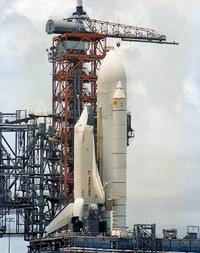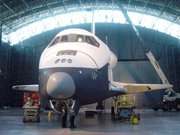Space Shuttle Enterprise
|
|
| Space Shuttles |
|
Missing image
Missing image |

The Shuttle Orbiter Enterprise (NASA Orbiter Vehicle Designation: OV-101) was the first Space Shuttle built for NASA. It was initially constructed without engines or a functional heat shield and was therefore not capable of space operations without a refit. It was intended to be the second space shuttle to fly after the Space Shuttle Columbia even though Enterprise was built first; however, it was found to be cheaper to refit a test article (STA-099) into the Space Shuttle Challenger. Similarly, it was considered for refit to replace Challenger, but Space Shuttle Endeavour was built from spares instead.
Originally planned to be called Constitution, a write-in campaign caused the test vehicle to be renamed after the Starship Enterprise, featured on the television show Star Trek. Most of the cast of the original series, as well as Star Trek creator Gene Roddenberry, were on hand at the dedication ceremony, and the show's theme music was played. A mural in the captain's office in Star Trek: The Next Generation depicts this Space Shuttle as one of the starship's own namesakes, and images in the opening credits of the series Star Trek: Enterprise pay similar tribute. Oddly, Star Trek: Deep Space Nine later pictured a model of the International Space Station with the Space Shuttle Enterprise docked with it, despite the fact that Enterprise has never been fitted for launch into space.
Space_Shuttle_Enterprise.jpg
Enterprise was used by NASA for a variety of ground and flight tests intended to validate aspects of the shuttle program. The initial nine-month testing period was referred to by the acronym ALT for "Approach and Landing Test". These tests included a maiden "flight" on February 18, 1977 atop a Boeing 747 Shuttle Carrier Aircraft (SCA) to measure structural loads and ground handling and braking characteristics of the mated system. Ground tests of all orbiter subsystems were carried out to verify functionality prior to atmospheric flight. These ALT tests took place at NASA's Dryden Flight Research Center at Edwards Air Force Base, California.
The mated Enterprise/SCA combination was then subjected to five test flights with Enterprise unmanned and unactivated. The purpose of these test flights was to measure the flight characteristics of the mated combination. These tests were followed with three test flights with Enterprise manned in order to test the shuttle flight control systems.
Finally, Enterprise underwent five free flights where the craft separated from the SCA and was landed under astronaut control. These tests verified the craft's flight characteristics and were carried out under several aerodynamic and weight configurations. See ALT table below for complete list of ALT flight tests.
Following the ALT program, Enterprise was ferried between several NASA facilities to configure the craft for vibration testing. Ultimately it was mated with an external tank and solid rocket boosters and tested in a launch configuration.
With the completion of critical testing, Enterprise was partially disassembled to allow certain components to be reused in other shuttles, then underwent a world tour visiting France, Germany, Italy, the United Kingdom, Canada, and the US states of California, Alabama, and Louisiana. It was also used to fit-check the never-used shuttle launch pad at Vandenberg AFB, California. Finally, on November 18, 1985, Enterprise was ferried to Washington, D.C., where it became property of the Smithsonian Institution.
Enterprise was at the Smithsonian's hangar at Washington Dulles International Airport before being moved to the Smithsonian's National Air and Space Museum's Steven F. Udvar-Hazy Center at Dulles, where it is on display.
According to NASA's Dr. Jesco von Puttkamer, Enterprise was not equipped to launch into space but was intended from the outset for ALT flight testing of the craft during the critical approach and landing phase as an unpowered glider. For this purpose, the ship was lofted up to altitude on the back of a Boeing 747 carrier aircraft and then released for free and piloted flight back to the landing at Edwards Air Force Base. Structurally, Enterprise was not suited to be converted to be spaceworthy later, and so it was sent to Silver Hill.
In 2003, after the breakup of the Shuttle Columbia during re-entry, fiberglass panels were removed from Enterprise, to undergo testing [1] (http://spaceflightnow.com/shuttle/sts107/030604foamtest/). The single test involved firing a piece of foam at high velocity at the panel. A piece of foam, covering the external fuel tank, broke off and struck the leading edge of Columbia's left wing during launch. It was widely speculated that this impact caused a breach of the vehicle, allowing in super-heated gases during re-entry, leading to Columbia's destruction. During the test, while the panels were not broken, the impact was enough to expose a seal between them.
| Contents |
Enterprise ALT flights
| Test Flight | Date | Speed | Altitude | Crew | Duration | Comment |
|---|---|---|---|---|---|---|
| Taxi Test #1 | February 15, 1977 | 89 mph 143 km/h | taxi | none | taxi | Concrete runway, tailcone on |
| Taxi Test #2 | February 15, 1977 | 140 mph 225 km/h | taxi | none | taxi | Concrete runway, tailcone on |
| Taxi Test #3 | February 15, 1977 | 157 mph 253 km/h | taxi | none | taxi | Concrete runway, tailcone on |
| Captive-Inert Flight #1 | February 18, 1977 | 287 mph 462 km/h | 16,000 ft 4,877 m | none | 2 hrs 5 min | Tailcone on, landed with 747 |
| Captive-Inert Flight #2 | February 22, 1977 | 328 mph 528 km/h | 22,600 ft 6,888 m | none | 3 hrs 13 min | Tailcone on, landed with 747 |
| Captive-Inert Flight #3 | February 25, 1977 | 425 mph 684 km/h | 26,600 ft 8,108 m | none | 2 hrs 28 min | Tailcone on, landed with 747 |
| Captive-Inert Flight #4 | February 28, 1977 | 425 mph 684 km/h | 28,565 ft 8,707 m | none | 2 hrs 11 min | Tailcone on, landed with 747 |
| Captive-Inert Flight #5 | March 2, 1977 | 474 mph 763 km/h | 30,000 ft 9,144 m | none | 1 hrs 39 min | Tailcone on, landed with 747 |
| Captive-Active Flight #1 | June 18, 1977 | 208 mph 335 km/h | 14,970 ft 4,563 m | Fred Haise, Gordon Fullerton | 55 min 46 sec | Tailcone on, landed with 747 |
| Captive-Active Flight #2 | June 28, 1977 | 310 mph 499 km/h | 22,030 ft 6,715 m | Joe Engle, Richard Truly | 62 min 0 sec | Tailcone on, landed with 747 |
| Captive-Active Flight #3 | July 26, 1977 | 311 mph 501 km/h | 30,292 ft 9,233 m | Fred Haise, Gordon Fullerton | 59 min 53 sec | Tailcone on, landed with 747 |
| Free Flight #1 | August 12, 1977 | 310 mph 499 km/h | 24,100 ft 7,346 m | Fred Haise, Gordon Fullerton | 5 min 21 sec | Tailcone on, lakebed landing |
| Free Flight #2 | September 13, 1977 | 310 mph 499 km/h | 26,000 ft 7,925 m | Joe Engle, Richard Truly | 5 min 28 sec | Tailcone on, lakebed landing |
| Free Flight #3 | September 23, 1977 | 290 mph 467 km/h | 24,700 ft 7,529 m | Fred Haise, Gordon Fullerton | 5 min 34 sec | Tailcone on, lakebed landing |
| Free Flight #4 | October 12, 1977 | 278 mph 447 km/h | 22,400 ft 6,828 m | Joe Engle, Richard Truly | 2 min 34 sec | Tailcone off, lakebed landing |
| Free Flight #5 | October 26, 1977 | 283 mph 456 km/h | 19,000 ft 5,791 m | Fred Haise, Gordon Fullerton | 2 min 1 sec | Tailcone off, runway landing |
- Shuttle Carrier Aircraft (747) Crew For All Tests:
- Fitzhugh L. Fulton, Jr., Pilot
- Thomas C. McMurtry, Pilot
- Louis E. Guidry, Jr., Flight Engineer
- Victor W. Horton, Flight Engineer
Media
Template:Multi-video start Template:Multi-video item Template:Multi-video item Template:Multi-video item Template:Multi-video end
Related articles
External links
- Orbiter Vehicles (http://science.ksc.nasa.gov/shuttle/resources/orbiters/orbiters.html)
- Shuttle Orbiter Enterprise (OV-101) (http://science.ksc.nasa.gov/shuttle/resources/orbiters/enterprise.html)
da:Enterprise (rumfærge) de:Enterprise (Raumfähre) fr:Navette spatiale Enterprise it:Space Shuttle Enterprise nl:Space Shuttle Enterprise ja:エンタープライズ (オービタ) sv:Enterprise (rymdfärja) zh:企業號太空梭

